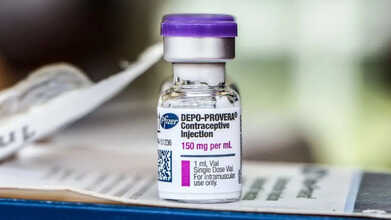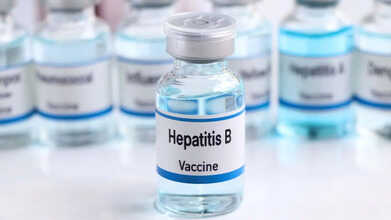- Health Conditions A-Z
- Health & Wellness
- Nutrition
- Fitness
- Health News
- Ayurveda
- Videos
- Medicine A-Z
- Parenting
NHS UK Warns People To Stay At Home Amid Norovirus Outbreak

Credits: Canva
Earlier this month bug outbreak was reported in UK schools where parents claimed that children were vomiting. The reason for this outbreak was norovirus. This is a group of viruses that cause severe vomiting and diarrhea.
NHS Guidelines
The National Health Service (NHS) has urged people who catch norovirus to stay home and recover as cases of the illness surged in December. Known as the "stomach flu," norovirus is highly contagious and can cause diarrhoea, vomiting, nausea, and stomach pain. Although the symptoms are “very unpleasant,” healthcare professionals say the illness usually clears up within two days.
In a warning shared on X. previously Twitter, the NHS stated:
“Norovirus is a stomach bug that causes diarrhoea and vomiting. It can be very unpleasant, but usually goes away in about two days. If you catch it; stay home, rest, and have plenty of fluids.”
How do you get the virus?
For most people, having norovirus is unpleasant, but mild and recovery could be made in 1 to 2 days. However, it could be more serious for babies, older people and anyone with any existing health condition.
Anyone can get the virus by accidentally getting particles of virus in your mouth and ingesting it. These particles are from faeces or vomit from infected people, or can be transmitted via contaminated food and water. It could also spread by touching unclean surfaces like door handles or cutlery.
It is also the No.1 cause of foodborne illness in the US and first occurred in Norwalk, Ohio, in a school in 1968. This is why the first strain is named after the location and is called the Norwalk virus.
There are also several types of strain, which can cause inflammation of your stomach. There are 10 groups and 48 types in the Caliciviridae family of virus, from where norovirus also belongs. The most common type is GII.4. It also affects around 685 million people each year, out of those, 200 million are children.
Norovirus Cases and Hospital Admissions
Recent NHS data reveals an 86% increase in norovirus cases in hospitals compared to the same week last year. On average, 756 patients were treated for norovirus in hospital beds daily during one week in December. Each year, norovirus is linked to approximately 12,000 hospital admissions in the UK, with vulnerable individuals, such as those with weakened immune systems, at greater risk of severe illness.
Impact on Hospitals Amidst a ‘Quad-Demic’
This surge in norovirus cases comes at a challenging time for the NHS. Officials reported record levels of flu, alongside rising cases of Covid-19 and respiratory syncytial virus (RSV), creating what has been dubbed a “quad-demic.” NHS data showed a 41% jump in flu-related hospitalizations within a week in early December, with figures more than four times higher than the same period last year.
Norovirus Transmission and Prevention
Cases of norovirus typically rise in autumn and peak during winter. However, this year, the increase started earlier than usual, except for a brief dip during the October half-term school holidays. Officials suggest this highlights how schools contribute to the spread of the virus.
The UK Health Security Agency has warned that the true impact of norovirus is likely underreported because most people recover without seeking medical help. To limit the spread, people are advised to:
- Wash hands thoroughly with soap and warm water, as alcohol-based sanitisers are ineffective against norovirus.
- Disinfect surfaces with a bleach-based cleaner.
- Stay home for at least 48 hours after symptoms stop to avoid passing the virus to others.
Depo Provera: New FDA Label Highlights Possible Brain Tumor Risk

Credits: AP
Depo Provera: The Food and Drug Administration approved a label change on Friday for Pfizer’s birth control injection, Depo-Provera, alerting patients to the risk of meningioma, a tumor that develops in the lining of the brain.
Pfizer is currently facing a lawsuit from over 1,000 women who allege that the company knew about the risk but failed to warn users.
How Depo-Provera Works
Depo-Provera is administered as a progestin injection every three months. The lawsuit highlights studies dating back to 1983 linking progesterone with meningioma, claiming that Pfizer had an “unassignable duty to investigate” and should have examined the potential risks of Depo-Provera much earlier. (Progestin is a synthetic form of progesterone.)
According to the Centers for Disease Control and Prevention, roughly one in four sexually active women in the U.S. has used Depo-Provera, with Black women using it at nearly twice the national rate.
Depo Provera: Understanding Meningiomas
Meningiomas are generally non-cancerous, meaning they do not spread to other areas of the body. However, depending on their size and location, they can still be dangerous. In the U.S., about 39,000 meningiomas are diagnosed annually, though the overall risk remains small, as per CDC.
Depo Provera: Pfizer’s Response and FDA Review
Earlier this year, Pfizer requested a judge dismiss the lawsuit, stating that it became aware of the meningioma risks linked to Depo-Provera in 2023. In February 2024, the company applied to the FDA to add a warning to the injection’s label, also requesting warnings for two lower-dose pills containing medroxyprogesterone acetate (MPA), the active ingredient in the shot, as per NBC News.
The FDA denied the request for the pills, explaining that “the findings of the available observational studies alone do not support the addition of a warning on Meningioma risk to medroxyprogesterone acetate (MPA)-containing products.”
Pfizer then amended and resubmitted the application in June 2025. In response, the FDA approved a label change this month for two injection versions — Depo-Provera CI and Depo-Subq Provera 104.
“We acknowledge receipt of your amendment dated June 12, 2025,” the FDA letter to Pfizer said. The approval “provides for the addition of information related to Meningioma risk” on the product label.
Depo Provera: Pfizer’s Statement
A Pfizer spokesperson told NBC News that “the label update reflects a recent decision by the FDA to approve the warning, which the agency had earlier denied.”
“Pfizer stands behind the safety and efficacy of Depo-Provera, which has been used by millions of women worldwide and remains an important treatment option for women seeking to manage their reproductive health,” the statement added.
Lawyers representing the women suing Pfizer said: “For years, Pfizer misled doctors, patients, and the FDA about Depo-Provera’s link to meningiomas, resulting in needless suffering for thousands of women who developed these serious brain tumors. … We applaud the FDA in finally requiring this label change to better inform and protect women.” The FDA did not immediately respond to requests for comment. Elsewhere, warnings about meningioma have already been added to Depo-Provera’s label.
In 2024, the European Medicines Agency listed meningioma as a “possible side effect” for drugs with high doses of MPA. That same year, Canada updated the drug’s label to include meningioma under “warnings and precautions,” noting that meningiomas have been reported following long-term use of progestins, including MPA.
As per NBC News, in January, South Africa’s regulatory agency recommended updating the MPA drug label to include meningioma risk as well. The judge has not yet issued a ruling in the ongoing lawsuit against Pfizer in the United States.
CDC Formally Ends Universal Hepatitis B Vaccination Guidance—What Does It Mean For Newborns?

Credits: Canva
The U.S. Centers for Disease Control and Prevention on Tuesday withdrew its decades-old guidance that all newborns in the country should be vaccinated against hepatitis B at birth. Instead, the decision has now been shifted to parents, who are advised to consult a healthcare provider when deciding whether babies born to hepatitis B-negative mothers should receive the vaccine, including the birth dose.
The change follows a recommendation made by Health Secretary Robert F. Kennedy Jr.’s vaccine advisory panel, marking a significant shift in public health policy. Earlier this month, the panel suggested that the birth dose be limited to newborns whose mothers test positive for hepatitis B or whose infection status is unknown. The CDC approved this recommendation as official policy on Tuesday. Here is what this change means for newborns moving forward:
Also Read: Indoor Air In Delhi Is More Toxic Than Outdoor Smog, Pulmonologist Warns
CDC Ends Guidance That All Newborns Should Get Hepatitis B Vaccine
Under the updated guidance, if parents decide against vaccinating their baby at birth but later believe the shot is necessary, the CDC now advises waiting until the child is at least two months old before administering the first dose. Since 1991, U.S. health authorities have supported universal infant vaccination against hepatitis B, with the first of three doses typically given shortly after birth. CDC recommendations influence health insurance coverage decisions and serve as a key reference point for doctors when determining vaccine schedules.
Public health experts have raised concerns that the shift toward what the CDC calls “individual-based decision-making” may leave more children vulnerable to the virus and could encourage families to skip vaccination without a strong federal directive. Kennedy, who has long opposed vaccines, has already introduced sweeping changes to the country’s vaccination policies.
CDC New Guidance On Hepatitis B Vaccine: What Does This Mean For Newborns?
Rather than advising hepatitis B vaccination for every newborn, the CDC now formally recommends that women who test negative for the virus discuss with their healthcare providers whether their babies should receive the first dose within 24 hours of birth. According to NBC News, the agency is also evaluating another proposal from the advisory panel, which suggests parents consult doctors about testing children for hepatitis B antibodies before deciding on second doses of the vaccine. Typically, the hepatitis B vaccine is administered as a three-dose series during infancy.
Also Read: ‘Fix Your Handwriting’: Indian Doctors Told to Write Clear, Legible Prescriptions Under New Rules
This policy shift stands out as one of the clearest departures from established medical consensus reflected in current CDC guidance. During discussions, the advisory committee relied on selective data and misinformation, while overlooking decades of research showing that hepatitis B vaccines are both safe and highly effective when given soon after birth.
“Removing the recommendation for newborns increases the likelihood that case numbers will rise again. This makes America sicker,” Senator Bill Cassidy, R-La., a liver specialist who has treated hepatitis B patients, wrote on X earlier this month. Despite the change, pediatricians are still expected to encourage parents to vaccinate their newborns.
The Department of Health and Human Services has stated that the updated guidance will not change insurance coverage for the vaccine. The shots will also remain available to newborns through the Vaccines for Children Program, which provides vaccines at no cost to uninsured or underinsured families.
Last month, the CDC also revised a webpage that had previously stated clearly that vaccines do not cause autism. The updated language now says studies have not ruled out a link, despite decades of scientific evidence showing no connection between vaccines and autism.
‘Fix Your Handwriting’: Indian Doctors Told to Write Clear, Legible Prescriptions Under New Rules

Credits: iStock
No more scribbling, notes a BBC report from October 1, 2025, where the Punjab and Haryana court tells doctors to fix their handwriting. Now, the National Medical Commission or NMC has issued nationwide order to the doctors to ensure their prescriptions are written in a clear and legible manner.
While jokes around the notoriously bad handwriting of many doctors that only can be read by pharmacist are common in India, but after the High Court's ruling, this joke is taken seriously. The High Court noted that "legible medical prescription is a fundamental right" as it can make a difference between life and death.
What Are The New NMC Guidelines On Doctor's Handwriting?
Under the new directive, the NMC ordered that doctors must:
- Write prescriptions in clear, legible handwriting, avoiding ambiguity.
- Arbitrary or unclear prescription writing will no longer be acceptable, as it compromises patient safety.
- Subcommittees will be formed in all medical colleges to monitor prescription practices and ensure compliance.
- Medical students will be taught the importance of clear prescription writing, making it a core part of clinical training.
The Background Of NMC Guidelines

The Punjab and Haryana High Court ordered doctors to fix their handwritings while it was looking at a case that involved allegations of rape. While checking a medico-legal report written by a government doctor who examined the woman, the court found it incomprehensible.
Justice Jasgurpreet Singh Puri said, "It shook the conscience of this court as not even a word or a letter was legible".
"At a time when technology and computers are easily accessible, it is shocking that government doctors are still writing prescriptions by hand which cannot be read by anybody except perhaps some chemists," said Justice Puri.
Importance Of Clear Prescriptions
The World Health Organization (WHO) identifies medication errors as a major global patient safety challenge, contributing to avoidable injuries and deaths worldwide. Illegible prescriptions are a well-recognised cause of such errors.
A clear and readable prescription also:
Prevents misinterpretation
Poor handwriting leads to misinterpretation of the intended drug name, dosage, or instructions. Many drugs have names that look or sound alike, making clarity critical.
Ensures the right dosage
Unclear instructions when it comes to dosing result in giving out doses that are ten or one hundred times the correct amount, leading to toxicity or therapeutic failure.
Empowers patient understanding
When the patients are able to clearly read and understand the prescriptions and medication labels, they are more likely to take their medications correctly, reducing the margin for errors.
Reduces healthcare costs
Medication errors resulting from unclear prescriptions lead to increased hospital admissions, prolonged lengths of stay, and additional costs, placing a significant burden on the patient and the healthcare system.
© 2024 Bennett, Coleman & Company Limited

